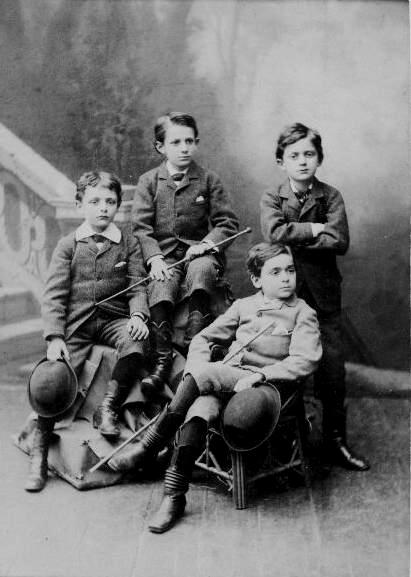
German Boys' Clothes: Suit Chronology--19th Century

Figure 1.--This cabinet card shows four boys wearing similar lapel suits. They all have long knee pants worn with long stockings. Two opf the boys wear rounded-crown hats. Given that the boys are close in age, they were not a family group. We are not sure about their relationship. The studio was Fritz Heomann in Coblenz. The dealer thinks that they were photographed in the 1870s. We think the 1880s may be more likely. A German reader tells us, 'In this case I think it is the very early-1880s or maybe late-70s. It is difficult to date as this card has not much advertisement and the boys' suits are rather plain. There are German 1870s cabinet cards, but many more CDVs during the 70s.' One factor is thatliongstockings were still more common in the 70s.
|
|
We still have limited information on German 19th century suits, although we have begun to develop some information. Some information is available from paintings and drawings for the erly 19th century. Photography was developed in France during 1839. We have not yet managed to find images of German boys during the 1840s and 50s. Daguerreotypes and other early hotographs do not seem as common in Germany as is the case in America. And we have not yet been able to archive any. Beginng in the 1860s with CDVs we do begin to find subtantial numbers of photographic portraits. German boys in the 19th century almost always wore suits for studio portraits. We are just beginning to assess these images. We see boys wearing cut-away jackets with both long pants and bloomer knickers. We note many boys wearing collar-buttoning jackets. We also notice a variety of lapel jackets. Norfolk jackets were a popular style.
1850s
Photography was developed in France during 1839. We have not yet managed to find images of German boys during the 1840s and 50s. Daguerreotypes and other early photographs do not seem as common in Germany as is the case in America. And we have not yet been able to archive any. Thus our knowledge of clothing trends is still very limited.
We have very few images of the suits German boys wore in the 1860s so our information is still quite limited. We notice suit jackets with collars rather than lapels like the boy's jacket here (figure 1). The portrait here is undated, but looks to have been taken in the 1860s. All we know about the portrait is that is was taken in Chemnitz, Germany. The jacket here has three buttons andi believe a collar button. Vests or waistcoats were common. The jackets are styled very plainly without any detailing at all. Most images we have seen show boys wearing long pants suits. The boy here is quite young. We do not know his precise age, perhaps about 9 years old, but he is wearing a long pants suit. Many of the suits do not seem to have a well-fitted look. Ready made suits were still not common.
We see German boys wearing both cut-away jacket and lael jacket suits in the 1870s, commonly with long trousers. The younger boys wore cut=awau jackets. Somewhat older boys had jackets with high-set lapels. Some lapels had velvet trim. Older teenagers might wear jackets styled more like frock coats. We note that stripes on the panys were a popular decoration. This was a military style. We note syits both with matching and contrasting trousers. We begin to see more German boys wearing kneepants suits in the 1870s, but only some of the younger boys. Boys in the late-19th century and early 20th century commonly wore knee pants, but this was not yet common in the 1870s, especially the early-70s. Most of the portrits we have archived in the 1870s show school-age boys wearing long pants suits. We bgin to see some of the younger boys at school wearing knee paats or bloomer knickelies, although we are not yet sure how common this was. We also do not yet have a large enough archive to develop any assessments as to social-class and other conventions.
German boys in the 1880s wore a variety of different suits. There was still quite a variety of styles, but more uniformity than in the 1870s. We notice boys wearing both single and double breasted suits. Cut-away jackets declined sharply in popularity. Sack suit jackets tended to have high set, small lapels. We also notice collar-buttoning suits without lapels. There were also different kinds of pants, including long pants, bloomer knickers, and knee pants. Long pants tended to be the dominant style for boys, but we see more younger school age boys beginning to wear knee pants. We also see girls with dresses styled like suits. The Little Lord Fauntleroy suit appeared during the 1880s, but was not nearly as popular in Germany as in America. We note German brothers in the 1880s wearing matching velvet suits.
The 1890s
HBC

Navigate the Boys' Historical Clothing German pages:
[Return to the Main German suit chronology page]
[German choirs]
[German scouts]
[Hitler Youth]
[German school uniforms]
[German royalty]
[German sailor suits]
[Lederhosen]
[Ethnic]
[Tights]
[Long stockings]
Navigate the Boys' Historical Clothing Web Site:
[Introduction]
[Activities]
[Biographies]
[Chronology]
[Clothing styles]
[Countries]
[Topics]
[Bibliographies]
[Contributions]
[FAQs]
[Glossaries]
[Images]
[Links]
[Registration]
[Tools]
[Boys' Clothing Home]
Created: 9:18 PM 6/19/2011
Last updated: 7:49 AM 11/12/2012



